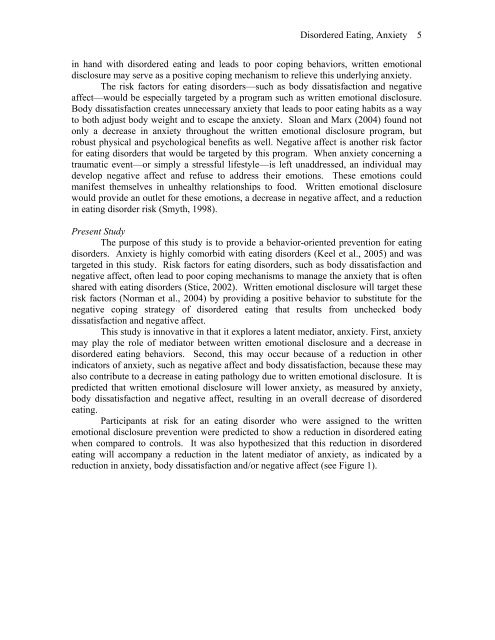The Secret Society: Descendants of Crypto-Jews in the San Antonio ...
The Secret Society: Descendants of Crypto-Jews in the San Antonio ...
The Secret Society: Descendants of Crypto-Jews in the San Antonio ...
You also want an ePaper? Increase the reach of your titles
YUMPU automatically turns print PDFs into web optimized ePapers that Google loves.
Disordered Eat<strong>in</strong>g, Anxiety 5<br />
<strong>in</strong> hand with disordered eat<strong>in</strong>g and leads to poor cop<strong>in</strong>g behaviors, written emotional<br />
disclosure may serve as a positive cop<strong>in</strong>g mechanism to relieve this underly<strong>in</strong>g anxiety.<br />
<strong>The</strong> risk factors for eat<strong>in</strong>g disorders—such as body dissatisfaction and negative<br />
affect—would be especially targeted by a program such as written emotional disclosure.<br />
Body dissatisfaction creates unnecessary anxiety that leads to poor eat<strong>in</strong>g habits as a way<br />
to both adjust body weight and to escape <strong>the</strong> anxiety. Sloan and Marx (2004) found not<br />
only a decrease <strong>in</strong> anxiety throughout <strong>the</strong> written emotional disclosure program, but<br />
robust physical and psychological benefits as well. Negative affect is ano<strong>the</strong>r risk factor<br />
for eat<strong>in</strong>g disorders that would be targeted by this program. When anxiety concern<strong>in</strong>g a<br />
traumatic event—or simply a stressful lifestyle—is left unaddressed, an <strong>in</strong>dividual may<br />
develop negative affect and refuse to address <strong>the</strong>ir emotions. <strong>The</strong>se emotions could<br />
manifest <strong>the</strong>mselves <strong>in</strong> unhealthy relationships to food. Written emotional disclosure<br />
would provide an outlet for <strong>the</strong>se emotions, a decrease <strong>in</strong> negative affect, and a reduction<br />
<strong>in</strong> eat<strong>in</strong>g disorder risk (Smyth, 1998).<br />
Present Study<br />
<strong>The</strong> purpose <strong>of</strong> this study is to provide a behavior-oriented prevention for eat<strong>in</strong>g<br />
disorders. Anxiety is highly comorbid with eat<strong>in</strong>g disorders (Keel et al., 2005) and was<br />
targeted <strong>in</strong> this study. Risk factors for eat<strong>in</strong>g disorders, such as body dissatisfaction and<br />
negative affect, <strong>of</strong>ten lead to poor cop<strong>in</strong>g mechanisms to manage <strong>the</strong> anxiety that is <strong>of</strong>ten<br />
shared with eat<strong>in</strong>g disorders (Stice, 2002). Written emotional disclosure will target <strong>the</strong>se<br />
risk factors (Norman et al., 2004) by provid<strong>in</strong>g a positive behavior to substitute for <strong>the</strong><br />
negative cop<strong>in</strong>g strategy <strong>of</strong> disordered eat<strong>in</strong>g that results from unchecked body<br />
dissatisfaction and negative affect.<br />
This study is <strong>in</strong>novative <strong>in</strong> that it explores a latent mediator, anxiety. First, anxiety<br />
may play <strong>the</strong> role <strong>of</strong> mediator between written emotional disclosure and a decrease <strong>in</strong><br />
disordered eat<strong>in</strong>g behaviors. Second, this may occur because <strong>of</strong> a reduction <strong>in</strong> o<strong>the</strong>r<br />
<strong>in</strong>dicators <strong>of</strong> anxiety, such as negative affect and body dissatisfaction, because <strong>the</strong>se may<br />
also contribute to a decrease <strong>in</strong> eat<strong>in</strong>g pathology due to written emotional disclosure. It is<br />
predicted that written emotional disclosure will lower anxiety, as measured by anxiety,<br />
body dissatisfaction and negative affect, result<strong>in</strong>g <strong>in</strong> an overall decrease <strong>of</strong> disordered<br />
eat<strong>in</strong>g.<br />
Participants at risk for an eat<strong>in</strong>g disorder who were assigned to <strong>the</strong> written<br />
emotional disclosure prevention were predicted to show a reduction <strong>in</strong> disordered eat<strong>in</strong>g<br />
when compared to controls. It was also hypo<strong>the</strong>sized that this reduction <strong>in</strong> disordered<br />
eat<strong>in</strong>g will accompany a reduction <strong>in</strong> <strong>the</strong> latent mediator <strong>of</strong> anxiety, as <strong>in</strong>dicated by a<br />
reduction <strong>in</strong> anxiety, body dissatisfaction and/or negative affect (see Figure 1).
















